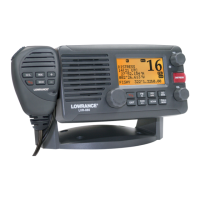
Do you have a question about the Lowrance LVR-880 EU and is the answer not in the manual?
| Type | VHF Marine Radio |
|---|---|
| Display | LCD |
| Power Output | 25W / 1W |
| DSC | Yes |
| GPS | No |
| Transmit Power | 25W / 1W |
| Waterproof Rating | IPX7 |
| DSC Class | D |
| Channels | International |
| Weight | 1.2 kg |
| Channels Number | 55 |
| Voltage Range | 13.8V DC |
Lists the key features and capabilities of the Lowrance LVR-880US/EU marine band VHF radio.
Details how to control the radio's power and adjust the volume level.
Explains how to set the squelch level to minimize background noise.
Instructions for using the Push-To-Talk button for transmissions.
Explains how to select high (25W) or low (1W) transmission power.
How to activate the DSC distress call function.
How to use the channel select knob to change radio channels.
How to display waypoint information and navigate.
How to mark and navigate to a Man Overboard position.
How to store, edit, and manage waypoints.
Procedure for adding a new waypoint to the list.
How to edit or remove existing waypoints.
How to manage GPS and time data.
How to manually input GPS coordinates and UTC time.
How to restore the radio to its factory settings.
How to configure weather alert preferences for US models.
How to enable or disable SAME alerts for weather warnings.
How to input county-specific SAME codes for weather alerts.
How to select an active SAME code for monitoring.
How to enter or verify the unique 9-digit MMSI number.
How to create, edit, or delete groups of contacts.
How to enter or verify the ATIS MMSI for European inland waterways.
How to enable or disable ATIS functionality.
How to enable or disable DSC functionality.
General instructions for initiating DSC calls.
How to make a DSC call to a specific person or contact.
How to send a DSC call to a pre-stored group.
How to broadcast a DSC call to all ships.
How to relay a distress call to an individual.
How to relay a distress call to all ships.
How to initiate a distress call.
How to handle an incoming distress call.
How to acknowledge or relay a distress call.
How to cancel an active distress call.
Solutions for when the radio fails to power on.
Troubleshooting steps for blown fuses.
Addressing low battery warnings.
Troubleshooting GPS connection and data loss issues.
Information on obtaining MMSI and radio licenses for DSC functions.